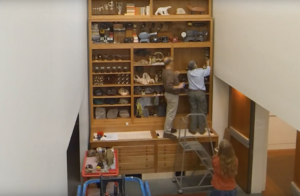Our second post for today comes from Mary-Kay Lombino, The Emily Hargroves Fisher ’57 and Richard B. Fisher Curator and Assistant Director for Strategic Planning. She shares what she is working on while the museum is closed.
People often ask me how long it takes to organize an exhibition. I find this to be one of those questions that are difficult to answer. Most curators, including myself, work on more than one project at a time. In my case, I usually have about four or five on my desk in various stages of development. In some ways, exhibition topics are like organisms – if you pay attention to their needs and make sure they are well fed, they will grow and mature naturally. From the first seed of an idea, to the final exhibition, it could take anywhere from several months to several years to fully blossom.

I’m currently working on one of those shows that will be several years in the making. The exhibition, currently titled The Polaroid Years: Instant Photography and Experimentation, is tentatively scheduled to open at the Art Center in fall 2012. The idea came to me about two years ago when The Warhol Foundation for the Visual Arts gave the Art Center, along with many other college and university museums, each about 150 photographs by Andy Warhol, many of which are small format, instant pictures taken with Polaroid cameras. Around the same time, Polaroid stopped production on all film and products related to the original instant camera. Ever since the SX-70 camera came out in 1972, instant photography has been of interest to artists. And now, with the Warhol Foundation gift, many of them are in museum collections. In addition, many other artists’ Polaroids have made their way into art collections, both public and private, as well as major monographic publications and exhibitions, yet there has never been a comprehensive survey of artist-made Polaroids or a study of what impact the innovative, now pervasive, technology of instant photography has made on the artists who have used it and on photography in general.
Researching a broad and ambitious topic like this one is an enormous undertaking and the kind of thing curators thrive on. But it requires a great deal of support. Here’s where the Warhol Foundation comes in again. I received a curatorial research grant to execute what I call the “hunting and gathering” phase of the exhibition. This is the period where I collect as much information as possible on the topic and organize it so that I can determine the scope and size of the exhibition along with particular themes that I’d like to explore and determine which artists with be included. In addition to Warhol Foundation support, I have Emily Kloppenburg serving as my Ford Scholar this summer. For the next several weeks Emily and I will meet with curators, dealers, artists, estates, and others to learn more about the role that Polaroid pictures played in certain artists’ work.
Today Emily and I are leaving for Switzerland on a research trip. We know that approximately 4,600 works from the Polaroid Corporation collection reside at the Musée de l’Elysée in Lausanne and we believe that several of these works will be relevant to our research. And I hope at least a few of them even make their way into the final exhibition checklist. While finalizing the checklist is still quite a long way off, at this stage I’m enjoying seeing that seed of an idea grow and change with every new discovery.




